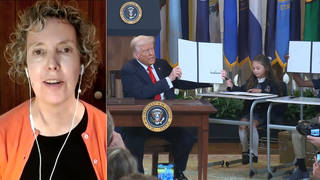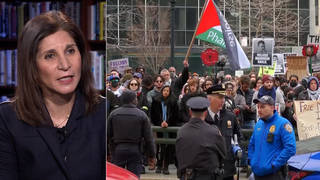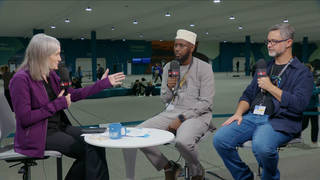
Topics
Guests
- Greg Grandinprofessor of Latin American history at NYU. His latest book is Fordlandia: The Rise and Fall of Henry Ford’s Forgotten Jungle City.
We speak with NYU professor Greg Grandin about his new book, Fordlandia: The Rise and Fall of Henry Ford’s Forgotten Jungle City. The book tells the story of Henry Ford, the richest man in the world in the 1920s, and his attempt to build a rubber plantation and a miniature Midwest factory town deep in the heart of the Brazilian Amazon. [includes rush transcript]
Transcript
AMY GOODMAN: We want to broaden this discussion, going beyond Honduras now to Latin America, to South America, in particular, to the new book that you just wrote, which is very interesting, Fordlandia: The Rise and Fall of Henry Ford’s Forgotten Jungle City. The book tells the story of Henry Ford, the richest man in the world in the 1920s, and his attempt to build a rubber plantation and a miniature Midwest factory town deep in the heart of the Brazilian Amazon. It’s a fascinating look, and especially with the demise of the auto industry in the United States, looking at US policy towards Latin America.
Tell us, what was Fordlandia?
GREG GRANDIN: Well, Fordlandia was the centerpiece town of a land grant concession, two-and-a-half million acres. It was the size of a small American state — Connecticut or Delaware, sometimes it was compared with Tennessee. And it was Ford’s attempt to get control over latex. It was the roar in 1920s. He controlled every raw material, he owned every raw material that went into the making of a car, except for rubber. And so, he moved into the Amazon. He moved into Brazil.
But it quickly became much more than that. It’s Henry Ford, and Henry Ford had — was quite an outsized historical figure. It became a bid to export America, Americana, to overlay Americana on Amazonia and replicate a small Midwestern American town deep in the heart of the Amazon.
JUAN GONZALEZ: And Ford, of course, was legendary in those days because he was the first major capitalist who believed in paying his workers a decent wage, in order for them to be able to make enough to buy the cars they were making, right?
GREG GRANDIN: Yeah.
JUAN GONZALEZ: Could you talk about his labor policies and how that got transferred —-
GREG GRANDIN: Yeah.
JUAN GONZALEZ: —- when he established himself in Brazil?
GREG GRANDIN: Yeah, Ford was the famous Fordism, the principle that if you paid workers $5 a day, it will allow them to buy the products that they make and thus expand the market, so profit was actually dependent on high wages. That was the idea. And for a long time, this was the centerpiece of US capitalism, and also, of course, his revolutionary assembly line process, which breaks the production process down to its simplest component. That all happens in the early 1910s.
By the 1920s, when he establishes Fordlandia, Ford is still being celebrated as the man who democratizes capitalism, but in reality, on the shop floor, he becomes to rely on quite a brutal program of anti-unionism. He relies on his thug, Harry Bennett, to enforce shop floor discipline with — that one historian compared to a totalitarian state. And so, in many ways, Fordlandia is Ford’s attempt to recapture a lost innocence or this mantle of being history’s redeemer. Ford revolutionizes capitalism, but then he spends most of the rest of his life trying to put the genie back into the bottle. In some ways, he’s the — you could think of him as the sorcerer’s apprentice. He attempts any number of experiments at social reform in the United States. He sets up these small, what he calls, village industries in northern Michigan that tries to balance agriculture and industry. Now, these were no match to the raw power of industrial capitalism. And he increasingly becomes idiosyncratic and quirky in his social vision. And Fordlandia, in many ways, is a kind of terminus of a lifetime of quite idiosyncratic ideas of how to organize society.
JUAN GONZALEZ: And he was into not only controlling the workers on the shop floor, but also their lives in general.
GREG GRANDIN: Yeah.
JUAN GONZALEZ: And he conducted — he had his employees surveilled, watched what they were doing, how they were enjoying themselves. And did he carry that over into Brazil, as well?
GREG GRANDIN: Yeah, it was a combination of intense paternalism and intense surveillance, with the surveillance half increasing as the paternalist part fails in the United States.
In Brazil, it was a program of social regulation. He exported Prohibition. He didn’t like drinking, even though it wasn’t a Brazilian law. Or he tried to regulate the diet of Brazilian workers. He had very — you know, he had them eat — he was a health food nut, so he had them eating whole rice and whole wheat bread and canned Michigan peaches and oatmeal. He also tried to regulate their recreational time.
JUAN GONZALEZ: He introduced square dancing to replace the samba.
GREG GRANDIN: Ford was a big proponent of old-time American dance. He didn’t like modern dance. He didn’t like jazz. He thought jazz was too sensual and too corrupting. So, in the United States, he was rescuing polkas and waltzes and square dances, and he did the same in Brazil.
AMY GOODMAN: I want to play an old clip about Fordlandia. This is from a 1944 US-produced documentary called The Amazon Awakens. It was made by Walt Disney but commissioned by the US Coordinator of Inter-American Affairs.
NARRATOR: Among the present-day pioneers of the Amazon who are lighting the way for others to follow is Henry Ford. Ford’s rubber development on the Tapajos River is an enterprise of historic proportion. Here, two million acres of jungle are being converted into a highly modernized plantation, capable of producing rubber on a large scale.
Deep in the wilderness, this model community is self-sufficient in every detail. It has its own power house, electric lighting, a telephone system, its own machine shop completely equipped with modern tools. There’s a laboratory for processing rubber, an ice plant and a fire department. There are nonprofit stores and shops, where food and clothing are sold to the employees. There’s modern road-building equipment, and 200 miles of roads have already been instructed to the plantation. Seventeen thousand acres of jungle have been cleared and planted.
Science and skill work hand-in-hand to produce the finest rubber trees possible. Ford has scoured the far corners of the Amazon, as well as Asia, for selected stock and uses it to build his own super rubber trees. Wild rubber trees produce from three to four pounds of rubber annually. But cultivated trees double and triple this amount, and their yield increases as the trees grow older. In processing the latex, the rubber is reduced to convenient forms, which facilitate handling and save shipping space.
Scientific care, the watchword of the plantation, is extended to the human element, too. Consistent with this policy, the 5,000 inhabitants are provided with every means of making life in the jungle healthy, happy and comfortable. The workers’ houses are clean and airy and offer a pleasant environment with modern conveniences.
Families living on the plantation are highly appreciative of the advantages offered. Their children are given every opportunity to develop into healthy, happy individuals. There are seven modern schools scattered through the plantation with a total enrollment of 1,200 children. Children of the big city may well envy these youngsters, who, in a healthy rural setting, are taught the three Rs, as well as physical culture and hygiene. There’s a day nursery, too, for the younger children whose mothers wish to work. Here, the youngsters are given the very best of care, including scientifically balanced meals. The best is none too good, for these are the future conquerors of the Amazon. Well, here they come. Nursery is over for the day, and bring brother is on hand to take the kiddies home. No transportation problem here.
The company hospital, with the best of modern equipment and excellently staffed, provides free medical aid for the employees.
Recreation is a prime essential in maintaining good health. Lively games serve a double purpose by relieving monotony, too. Later, an outdoor luncheon is served, followed by tempting delicacies. Then comes the afternoon round of golf, played on the plantation links against a beautiful jungle backdrop.
Today, the Ford plantation is a successful enterprise, a tribute to skill and science, the new weapons of the twentieth century pioneer.
AMY GOODMAN: The documentary The Amazon Awakens, an excerpt, that was made by Walt Disney but commissioned by the US Coordinator of Inter-American Affairs. Greg Grandin, author of Fordlandia, Walt Disney — he visited?
GREG GRANDIN: Yes, he visited prior to making this documentary. They were friends, Henry Ford and Walt Disney. And there was even evidence that some of the attractions in Disneyland in California were actually based on experience in Fordlandia, the Tropical Belle steamship ride or riverboat ride.
JUAN GONZALEZ: And what ultimately happened to the town? Because at least this documentary seems to portray all of the residents —-
GREG GRANDIN: Yeah.
JUAN GONZALEZ: —- as very happy with their surroundings.
GREG GRANDIN: Well, you know, let me say that, you know, Ford spent about a billion dollars, in inflation-adjusted dollars, on this project, and not one drop of latex made it into a Ford car. It was an absolute failure. And the more it failed, the more — this is also a resonance with recent history — the more it failed, the more he justified it in idealistic terms, not unlike, in some ways, the Iraq war. The more you fail to find weapons of mass destruction, the more it becomes a civilizational mission to bring democracy to the Middle East. The same thing with Fordlandia.
There were riots, and there were — workers rebelled against this attempt to impose Ford-style regimentation. One worker called it resisting being turned into 365-day machines.
And then, of course, the environmental aspect of it. Ford basically — by planting rubber trees so close together in the Amazon, Ford basically created a large incubator. Caterpillars and pests and blight just devastated the plantation. The more it failed, the more money that was poured into it.
AMY GOODMAN: And the people who were in the Amazon, the response there, the natives of the Brazilian Amazon?
GREG GRANDIN: Well, they did resist that heavy attempt to regulate every aspect of their lives, not just the industrial regime, but also their diet, their sanitation and medical regulation. And during one riot in particular, they smashed all the time clocks. This was a particularly symbolic rebellion against Midwestern industrialization.
AMY GOODMAN: And how you look today at the demise of the auto industry in the United States, the issue of globalization, how the Amazon — so many have tried to conquer it, corporations, right through to the Peruvian uprising recently in the Amazon, where indigenous people were killed protesting opening it to exploitation?
GREG GRANDIN: This story has a lot of resonance with today, Amy. What I — one of the things I like to say about the book is that it wasn’t Ford — Fordlandia is a story of arrogance, but the arrogance isn’t that Ford thought he could tame the Amazon — he was actually kind of indifferent to the Amazon — he thought he could tame capitalism.
Embedded in Fordism, Fordism — Ford imagined Fordism to be this very powerful integrating mechanism. High wages would create large markets and happy workers, and everybody would be happy. But I think embedded in Fordism was also the seeds of its undoing, that by breaking down the industrial process to ever smaller components, beginning in the factory, as Ford did, but then eventually throughout the larger global economy, you can break that link between high wages and large markets. You can make goods in one place and then sell them somewhere else, and it doesn’t matter. Your market share isn’t dependent on creating prosperous, happy workers.
And Fordlandia, in some ways, is very resonant with this. Just, you know — you go to Fordlandia, and there’s almost a yearning for this kind of holistic capitalism, a kind of paternal capitalism or developmentalism, where capital — where industries cared about what happened to workers, in terms of education, in terms of healthcare. But you go 300 miles east of Fordlandia, and there’s this city of Manaus, which is the fastest-growing city in Brazil. It’s a free trade port in the middle of the Amazon. It kind of sprawls out like some kind of perverse Oz eating away at the jungle. And nearly every major electronics corporation — Nokia, Sony, Sanyo, Harley-Davidson and other — Honda — have assembly plants there, where they make — where they assemble brand-name products for sale elsewhere in Latin America. So it’s a perfect example of how Fordism has been extended globally. So you have this nice two contrasts, Fordlandia and Manaus, side by side.
AMY GOODMAN: Greg Grandin, thank you very much for being with us. His latest book is Fordlandia: The Rise and Fall of Henry Ford’s Forgotten Jungle City.











Media Options